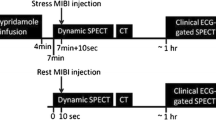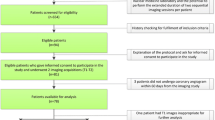Abstract
Background
The aim of this study was to compare global and regional left ventricular function in patients with coronary artery disease (CAD), obtained by use of Cedars-Sinai quantitative gated single photon emission computed tomography (QGS), for gated nitrogen 13 ammonia (NH3) positron emission tomography (PET) and technetium 99m sestamibi (MIBI) single photon emission computed tomography (SPECT).
Methods and Results
Fifty-one patients with CAD underwent gated N-13 NH3 PET and gated MIBI SPECT. The end-diastolic volume, end-systolic volume, and ejection fraction were calculated by use of QGS. The quantitative regional wall motion (WM) and wall thickening (WT) scores for 20 segments in the myocardium were also measured by QGS. The end-diastolic volume, end-systolic volume, and ejection fraction measured by N-13 NH3 PET showed highly significant correlation with those measured by MIBI SPECT (r=0.97, r=0.97, and r=0.84, respectively). The mean correlation of WM and WT on an individual patient basis between N-13 NH3 PET and MIBI SPECT was 0.81 and 0.84, respectively. The circumferential variation of WM and TT in 20 segments showed a similar pattern with N-13 NH3 PET and MIBI SPECT.
Conclusion
Gated N-13 NH3 PET combined with QGS provides information on both global and regional left ventricular function comparable to that obtained by gated Tc-99m perfusion myocardial SPECT in CAD patients.
Similar content being viewed by others
References
White HD, Norris RM, Brown MA, Brandt PWT, Whitlock RML, Wild CJ. Left ventricular end-systolic volume as the major determinant of survival after recovery from myocardial infarction. Circulation 1987;76:44–51.
Li YH, Teng JK, Tsai WC, Tsai, LM, Lin LJ, Guo HR et al. Prognostic significance of the evaluated hemostatic markers in patients with acute myocardial infarction. J Am Coll Cardiol 1999;33:1543–8.
Christiansen JP, Liang CS. Reappraisal of the Norris score and the prognostic value of the left ventricular ejection fraction measurement for in-hospital morality after acute myocardial infarction. J Am Cardiol 1999;83:589–91.
Sharir T, Germano G, Kavannagh PB, Lai S, Cohen I, Lewin HC, et al. Incremental prognostic value of post-stress left ventricular ejection fraction and volume by gated myocardial perfusion single photon emission computed tomography. Circulation 1999;100:1035–42.
Germano G, Kait H, Kavanagh PB, Moriel M, Mazzanti M, Su HT, et al. Automatic quantification of ejection fraction from gated myocardial perfusion SPECT. J Nucl Med 1995;36:2138–47.
Germano G, Erel J, Lewin H, Kavanagh PB, Berman SD. Automatic quantification myocardial wall motion and thickening from gated technetium-99m sestamibi myocardial perfusion singlephoton emission computed tomography. J Am Coll Cardiol 1997; 30:1360–7.
Germano G, Erel J, Kait H, Kavanagh PB, Berman SD. Quantitative LVEF and qualitative regional function from gated thallium-201 perfusion SPECT. J Nucl Med 1997;30:749–54.
Sharir T, Berman DS, Waecher PB, Areeda J, Kavanagh PB, Gerlach J et al. Quantitative analysis of regional motion and thickening by gated myocardial perfusion SPECT: normal heterogeneity and criteria for abnormality. J Nucl Med 2001;42:1630–8.
Willemsen ATM, Seibelink HJ, Blansma PK, Paans AM. Automated ejection fraction determination from gated myocardial FDG-PET data. J Nucl Cardiol 1999;6:577–82.
Schaefer WM, Lipke CSA, Nowark B, Kaiser HJ, Buecker A, Kormbach GA et al. Validation of an evaluation routine for left ventricular volumes, ejection fraction and wall motion from gated cardiac FDG PET: a comparison with cardiac magnetic resonance imaging. Eur J Nucl Med Mol Imaging 2003;30:545–53.
Schaefer WM, Lipke CSA, Nowark B, Kaiser HJ, Reinartz P, Buecker A et al. Validation of QGS and 4D-MSPECT for quantification of left ventricular volumes and ejection fraction from gated 18F-FDG PET: comparison with cardiac MRI. J Nucl Med 2004;45:74–9.
Saab G, deKemp RA, Ukkonen H, Rubby TD, Germano G, Beanlands RS. Gated fluorine 18 fluorodeoxyglucose positron emission tomography: determination of global and regional left ventricular function and myocardial tissue characterization. J Nucl Cardiol 2003;10:297–303.
Kanayama S, Matsunari J, Hirayama A, Kitayama M, Matsudaira M, Yoneyama T et al. Assessment of global and regional left ventricular function by electrocardiographic gated N-13 ammonia positron emission tomography in patients with coronary artery disease. Circ J 2005;69:177–82.
Korsand A, Graf S, Eidherr H, Wadsak W, Kletter K, Sochor H et al. Gated cardiac 13N-NH3 PET for assessment of left ventricular volumes, mass, and ejection fraction: comparison with electrocardiography-gated F18-FDG PET. J Nucl Med 2005;46:2009–13.
Schelbert HR, Phelps ME, Huang SC, MacDonald NS, Hansen H, Selin C et al. N-13 ammonia as an indicator of myocardial blood flow. Circulation 1981;63:1259–73.
Kirvokapich J, Smith GT, Huang SC, Hoffman EJ, Ratib O, Phelps ME, et al. 13N ammonia myocardial imaging at rest and with exercise in normal volunteers. Circulation 1989;80:1328–37.
Kuhle WG, Porenta G, Huang SC, Buxton D, Gambhir SS, Hansen H, et al. Quantification of regional myocardial blood flow using 13N ammonia and reoriented dynamic positron emission tomographic imaging. Circulation 1992;86:1004–17.
Choi Y, Huang SC, Hawkins RA, Kuhle WG, Dahlbom M, Hoh CK, et al. A simplified method for quantification of myocardial blood flow using N-13 ammonia and dynamic PET. J Nucl Med 1993;34:488–97.
DeGarado TR, Turkington TG, Williams JJ, Stearns CW, Hoffman JM, Coleman RE. Performance characteristics of a whole-body PET scanner. J Nucl Med 1994;35:1398–406.
Okazawa H, Takahashi M, Hata T, Sugimoto K, Kishibe Y, Tsuji T. Quantitative evaluation of myocardial blood flow and ejection fraction with a single dose of 13NH3 and gated PET. J Nucl Med 2002;43:999–1005.
Matsunari I, Kanayama S, Yoneyama T, Matsudaira M, Nakajima K, Taki J et al. Myocardial distribution of 18F-FDG and 99mTc-sestamibi on dual-isotope simultaneous acquisition SPECT compared with PET. Eur J Nucl Med 2002;29:1357–64.
Matsunari I, Bax JJ, Blanksma PK, Visser FC, Kanayama S, Yoneyama T et al. Effect of left ventricular function on diagnostic accuracy of FDG SPECT. Ann Nucl Med 2006;20:51–6.
Berman DS, Kiat H, Freidman JD, Wang FP, Train KV, Matzer L, et al. Separate acquisition rest thallium-201/stress technetium-99m sestamibi dual-isotope myocardial perfusion single-photon emission computed tomography. J Am Coll Cardiol 1993;22:1455–64.
Bland JM, Altman D. Statistical methods for assessing agreement between two methods of clinical measurement. Lancet 1986;1:307–10.
Nakata T, Katagiri Y, Odawara Y, Eguchi M, Kuroda M, Tsuchihashi K, et al. Two-and three-dimensional assessments of myocardial perfusion and function by using technetium-99m sestamibi gated SPECT with a combination of count-and image-based techniques. J Nucl Cardiol 2000;7:623–32.
Nakajima K, Nishimura T. Inter-institution preference-based variability of ejection fraction and volumes using quantitative gated SPECT with 99mTc-tetrophosmin: a multicentre study involving 106 hospitals. Eur J Nucl Med 2006;33:127–33.
Ambrosio G, Betocchi S, Pace L, Losi MA, Perrone-Filardi P, Soricelli A et al. Prolonged impairment of regional contractile function after resolution of exercise-induced angina. Evidence of myocardial stunning in patients with coronary artery disease. Circulation 1996;94:2455–64.
Johnson L, Verdesca SA, Aude WY et al. Postischemic stunning can affect left ventricular ejection fraction and regional wall motion on post-stress gated sestamibi tomograms. J Am Coll Cardiol 1997;30:1641–8.
Abidov A, Bax JJ, Hayes SW et al. Transient ischemic dilation ratio of the left ventricle is a significant predictor of future cardiac event in patients with otherwise normal perfusion SPECT. J Am Coll Cardiol 2003; 42:1818–25.
Nekolla SG, Meithaner CM, Nguen N, Zieger SI, Schwaiger M. Reproducibility of polar map generation and assessment of defect severity and extent assessment in myocardial perfusion imaging using positron emission tomography. Eur J Nucl Med 1998;25: 1313–21.
Author information
Authors and Affiliations
Corresponding author
Rights and permissions
About this article
Cite this article
Kanayama, S., Matsunari, I. & Kajinami, K. Comparison of gated N-13 ammonia PET and gated Tc-99m sestamibi SPECT for quantitative analysis of global and regional left ventricular function. J Nucl Cardiol 14, 680–687 (2007). https://doi.org/10.1016/j.nuclcard.2007.05.011
Received:
Accepted:
Issue Date:
DOI: https://doi.org/10.1016/j.nuclcard.2007.05.011




